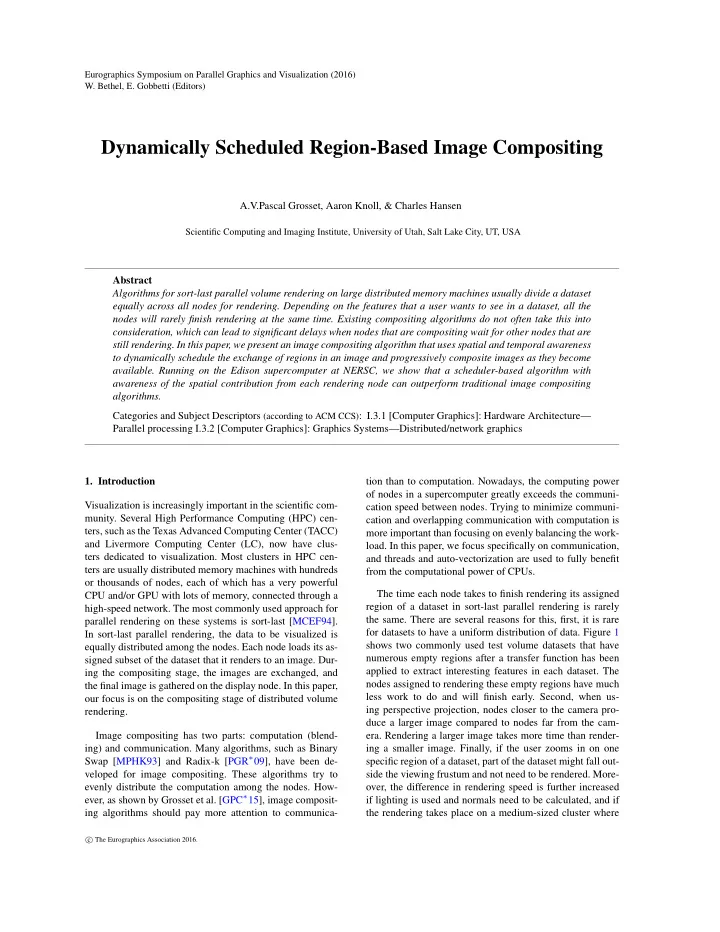

Eurographics Symposium on Parallel Graphics and Visualization (2016) W. Bethel, E. Gobbetti (Editors) Dynamically Scheduled Region-Based Image Compositing A.V.Pascal Grosset, Aaron Knoll, & Charles Hansen Scientific Computing and Imaging Institute, University of Utah, Salt Lake City, UT, USA Abstract Algorithms for sort-last parallel volume rendering on large distributed memory machines usually divide a dataset equally across all nodes for rendering. Depending on the features that a user wants to see in a dataset, all the nodes will rarely finish rendering at the same time. Existing compositing algorithms do not often take this into consideration, which can lead to significant delays when nodes that are compositing wait for other nodes that are still rendering. In this paper, we present an image compositing algorithm that uses spatial and temporal awareness to dynamically schedule the exchange of regions in an image and progressively composite images as they become available. Running on the Edison supercomputer at NERSC, we show that a scheduler-based algorithm with awareness of the spatial contribution from each rendering node can outperform traditional image compositing algorithms. Categories and Subject Descriptors (according to ACM CCS) : I.3.1 [Computer Graphics]: Hardware Architecture— Parallel processing I.3.2 [Computer Graphics]: Graphics Systems—Distributed/network graphics tion than to computation. Nowadays, the computing power 1. Introduction of nodes in a supercomputer greatly exceeds the communi- Visualization is increasingly important in the scientific com- cation speed between nodes. Trying to minimize communi- munity. Several High Performance Computing (HPC) cen- cation and overlapping communication with computation is ters, such as the Texas Advanced Computing Center (TACC) more important than focusing on evenly balancing the work- and Livermore Computing Center (LC), now have clus- load. In this paper, we focus specifically on communication, ters dedicated to visualization. Most clusters in HPC cen- and threads and auto-vectorization are used to fully benefit ters are usually distributed memory machines with hundreds from the computational power of CPUs. or thousands of nodes, each of which has a very powerful The time each node takes to finish rendering its assigned CPU and/or GPU with lots of memory, connected through a region of a dataset in sort-last parallel rendering is rarely high-speed network. The most commonly used approach for the same. There are several reasons for this, first, it is rare parallel rendering on these systems is sort-last [MCEF94]. for datasets to have a uniform distribution of data. Figure 1 In sort-last parallel rendering, the data to be visualized is shows two commonly used test volume datasets that have equally distributed among the nodes. Each node loads its as- numerous empty regions after a transfer function has been signed subset of the dataset that it renders to an image. Dur- applied to extract interesting features in each dataset. The ing the compositing stage, the images are exchanged, and nodes assigned to rendering these empty regions have much the final image is gathered on the display node. In this paper, less work to do and will finish early. Second, when us- our focus is on the compositing stage of distributed volume ing perspective projection, nodes closer to the camera pro- rendering. duce a larger image compared to nodes far from the cam- Image compositing has two parts: computation (blend- era. Rendering a larger image takes more time than render- ing) and communication. Many algorithms, such as Binary ing a smaller image. Finally, if the user zooms in on one Swap [MPHK93] and Radix-k [PGR ∗ 09], have been de- specific region of a dataset, part of the dataset might fall out- veloped for image compositing. These algorithms try to side the viewing frustum and not need to be rendered. More- evenly distribute the computation among the nodes. How- over, the difference in rendering speed is further increased ever, as shown by Grosset et al. [GPC ∗ 15], image composit- if lighting is used and normals need to be calculated, and if ing algorithms should pay more attention to communica- the rendering takes place on a medium-sized cluster where � The Eurographics Association 2016. c
Recommend
More recommend